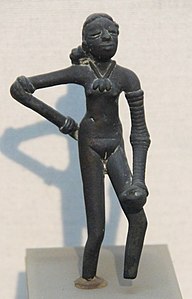Description
Throughout history, metal casting has been used to make tools, weapons, and religious objects. Metal casting history and development can be traced back to Southern Asia (China, India, Pakistan, etc). [3] Southern Asia traditions and religions relied heavily on statue and relic castings.[4] These items were frequently made from a copper alloy laced with lead.[5] Since the beginning of metallurgy the majority of castings were simple one to two piece molds fashioned from either stone or ceramics. However, there is evidence of lost wax castings in numerous ancient civilizations.[4]
The lost wax process originated in ancient Mesopotamia. The earliest known record of lost-wax casting is a clay tablet written in cuneiform in the ancient city of Sparta, Babylon, which specifically records how much wax is needed to cast a key.[6] The earliest-known castings in the global archaeological record were made in open stone molds.[7] There are two types of lost wax methods, direct lost wax method and indirect lost wax method. The direct molding method is to make the wax material into the same wax mold as the casting by hand or other tools; the indirect molding method is to make the wax mold through the mold. The direct molding method requires craftsmen to have a high technical level, otherwise the quality of castings cannot be guaranteed. However, the limitation of manual direct molding is that its efficiency is too low to achieve mass production. In this regard, indirect moulding has advantages. In indirect moulding, artisans usually make moulds from stone, wood, clay or other plastic materials.[8]
Early civilizations discovered lead aided in the fluidity of molten copper, allowing them to cast more intricate designs. For example, the dancing girl of Mohenjo-daro is a copper alloy casting that most likely utilizes the lost wax technique.[4] Lost wax casting can be dated back to 4000 BC or the Chalcolithic period.[4] One of the oldest studied examples of this technique is a 6,000-year old amulet from Indus valley civilization.[9]






You must log in or register a new account in order to contact the publisher
Useful information
- Avoid scams by acting locally or paying with PayPal
- Never pay with Western Union, Moneygram or other anonymous payment services
- Don't buy or sell outside of your country. Don't accept cashier cheques from outside your country
- This site is never involved in any transaction, and does not handle payments, shipping, guarantee transactions, provide escrow services, or offer "buyer protection" or "seller certification"







